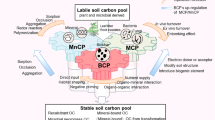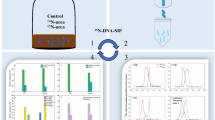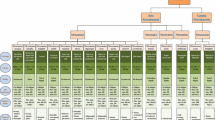Abstract
Intermittent drainage of rice fields isdiscussed as an option to mitigate emission ofCH4, an important greenhouse gas. HoweverN2O, a potentially more effective greenhouse gas,may be emitted during the aeration phase. Therefore,the metabolism of NO, N2O, NH\(_4^ + \),NO\(_2^ - \) and NO\(_3^ - \) and the kinetics ofCH4 oxidation were measured after aeration ofmethanogenic rice field soil. Before aeration, thesoil contained NH\(_4^ + \) in relatively highconcentrations (about 4 mM), while NO\(_2^ - \) andNO\(_3^ - \) were almost undetectable. Immediatelyafter aeration both NO and N2O were produced withrates of about 15 pmol h-1 gdw-1 and 5 pmolh-1 gdw-1, respectively. Simultaneously,NH\(_4^ + \) decreased while NO\(_2^ - \)accumulated. Later on, NO\(_2^ - \) was depletedwhile NO\(_3^ - \) concentrations increased.Characteristic phases of nitrogen turnover wereassociated with the activities of ammonium oxidizers,nitrite oxidizers and denitrifiers. Oxidation ofNH\(_4^ + \) and production of NO and N2O wereinhibited by 10 Pa acetylene demonstrating thatnitrification was obligatory for the initiation ofnitrogen turnover and production of NO and N2O.Ammonium oxidation was not limited by the availableNH\(_4^ + \)and thus, concomittant production of NOand N2O was not stimulated by addition ofNH\(_4^ + \). However, addition of NO\(_3^ - \)stimulated production of NO and N2O in bothanoxic and aerated rice soil slurries. In this case,10 Pa acetylene did not inhibit the production of NOand N2O demonstrating that it was due todenitrification which was obviously limited by theavailability of NO\(_3^ - \). In the aerated soilslurries CH4 was only oxidized if present atelevated concentrations >50 ppmv CH4). Atatmospheric CH4 concentrations (∼1.7 ppmv)CH4 was not consumed, but was even slightly produced.CH4 oxidation activity increased afterpreincubation at 20% CH4, and then CH4was also oxidized at atmospheric concentrations. CH4oxidation kinetics exhibited sigmoid characteristicsat low CH4 concentrations presumably because ofinhibition of CH4 oxidation by NH\(_4^ + \).
Similar content being viewed by others
References
Achtnich C, Bak F & Conrad R (1995) Competition for electron donors among nitrate reducers, ferric iron reducers, sulfate reducers, and methanogens in anoxic paddy soil. Biol Fertil Soils 19: 65–72
Bak F, Scheff G & Jansen KH (1991) A rapid and sensitive ion chromatographic technique for the determination of sulfate and sulfate reduction rates in freshwater lake sediments. FEMS Microbiol Ecol 85: 23–30
Baumgärtner M & Conrad R (1992) Effects of soil variables and season on the production and consumption of nitric oxide in oxic soils. Biol Fertil Soils 14: 166–174
Baumgärtner M, Koschorreck M & Conrad R (1996) Oxidative consumption of nitric oxide by heterotrophic bacteria in soil. FEMS Microbiol Ecol 19: 165–170
Bender M & Conrad R (1992) Kinetics of CH4 oxidation in oxic soils exposed to ambient air or high CH4 mixing ratios. FEMS Microbiol Ecol 101: 261–270
Bender M & Conrad R (1995) Effect of CH4 concentrations and soil conditions on the induction of CH4 oxidation activity. Soil Biol Biochem 27: 1517–1527
Bollmann A & Conrad R (1997) Acetylene blockage technique leads to underestimation of denitrification rates in oxic soil due to scavenging of intermediate nitric oxide. Soil Biol Biochem 29: 1067–1077
Bollmann A, Koschorreck M & Conrad R (1995) Zwei Methoden zur Messung des NO-Umsatzes in Böden. Mitt Dtsch Bodenkundl Ges 76: 513–516
Bosse U, Frenzel P & Conrad R (1993) Inhibition of methane oxidation by ammonium in the surface layer of a littoral sediment. FEMS Microbiol Ecol 13: 123–134
Bosse U & Frenzel P (1997) Activity and distribution of CH4-oxidizing bacteria in flooded rice microcosms and in rice plants (Oryza sativa). Appl Environ Microbiol 63: 1199–1207
Byrnes BH, Holt LS & Austin ER (1993) The emission of nitrous oxide upon wetting a rice soil following a dry season fallow. J Geophys Res 98: 22925–22929
Carlsen HN, Joergensen L & Degn H (1991) Inhibition by ammonia of methane utilization in Methylococcus capsulatus (Bath). Appl Microbiol Biotechnol 35: 124–127
Chalk PM & Smith CJ (1983) Chemodenitrification. Dev Plant Soil Sci 9: 65–89
Cicerone RJ & Oremland RS (1988) Biogeochemical aspects of atmospheric methane. Global Biogeochem Cycles 2: 299–327
Conrad R (1994) Compensation concentration as critical variable for regulating the flux of trace gases between soil and atmosphere. Biogeochem 27: 155–170
Conrad R (1995) Soil microbial processes involved in production and consumption of atmospheric trace gases. Adv Microb Ecol 14: 207–250
Conrad R. (1996a) Metabolism of nitric oxide in soil and soil microorganisms and regulation of flux into the atmosphere. In: Murrell JC & Kelly DP (Eds) Microbiology of Atmospheric Trace Gases: Sources, Sinks and Global Change Processes (pp 167–203). Springer, Berlin
Conrad R (1996b) Soil microorganisms as controllers of atmospheric trace gases (H2, CO, CH4, OCS, N2O, and NO). Microbiol Rev 60: 609–640
Conrad R & Rothfuss F (1991) Methane oxidation in the soil surface layer of a flooded rice field and the effect of ammonium. Biol Fertil Soils 12: 28–32
Conrad R, Schütz H & Babbel M (1987) Temperature limitation of hydrogen turnover and methanogenesis in anoxic paddy soil. FEMS Microbiol Ecol 45: 281–289
Dalton H (1977) Ammonia oxidation by the methane oxidising bacterium Methylococcus capsulatus strain Bath. Arch Microbiol 114: 273–279
Fetzer S, Bak F & Conrad R (1993) Sensitivity of methanogenic bacteria from paddy soil to oxygen and desiccation. FEMS Microbiol Ecol 12: 107–115
Firestone MK, Smith MS, Firestone RB & Tiedje JM (1979) The influence of nitrate, nitrite, and oxygen on the composition of the gaseous products of denitrification in soil. Soil Sci Soc Am J 43: 1140–1144
Firestone MK, Firestone RB & Tiedje JM (1980) Nitrous oxide from soil denitrification: Factors controlling its biological production. Science 208: 749–751
Freney JR & Denmead OT (1992) Factors controlling ammonia and nitrous oxide emissions from flooded rice fields. Ecol Bull (Copenhagen) 42: 188–194
Holzapfel-Pschorn A & Seiler W (1986) Methane emission during a cultivation period from an Italian rice paddy. J Geophys Res 91: 11803–11814
Kandeler E & Gerber H (1988) Short-term assay of soil urease activity using colorimetric determination of ammonium. Biol Fertil Soils 6: 68–72
Keeney DR & Nelson DW (1982) Nitrogen – inorganic forms. In: Page AL, Miller RH & Keeney DR (Eds) Methods of Soil Analysis, vol 2 (pp 643–698). American Society of Agronomy, Madison
Kimura M, Miura Y, Watanabe A, Katoh T & Haraguchi H. (1991) Methane emission from paddy field (part 1) Effect of fertilization, growth stage and midsummer drainage: Pot experiment. Environ Sci 4: 265–271
King GM & Schnell S (1994) Ammonium and nitrite inhibition of methane oxidation by Methylobacter albus BG8 and Methylosinus trichosporium OB3b at lowmethane concentrations. Appl Environ Microbiol 60: 3508–3513
King GM & Schnell S (1994) Effect of increasing atmospheric methane concentration on ammonium inhibition of soil methane consumption. Nature 370: 282–284
Klemedtsson L, Svensson BH & Rosswall T (1988) A method of selective inhibition to distinguish between nitrification and denitrification as sources of nitrous oxide in soil. Biol Fertil Soils 6: 112–119
Kuenen JG & Robertson LA (1994) Combined nitrification-denitrification processes. FEMS Microbiol Rev 15: 109–117
Le Mer J, Escoffier S, Chessel C & Roger P A. (1996) Microbiological aspects of methane emission in a ricefield soil from Carmargue (France): 2.Methanotrophy and related microflora. Eur J Soil Biol 32: 71–80
McKenney DJ, Drury CF, Findlay WI, Mutus B, McDonnell T & Gajda C (1994) Kinetics of denitrification by Pseudomonas fluorescens – oxygen effects. Soil Biol Biochem 26: 901–908
Ponnamperuma FN (1972) The chemistry of submerged soils. Adv Agronomy 24: 29–96
Poth M (1986) Dinitrogen production from nitrite by a Nitrosomonas isolate. Appl Environ Microbiol 52: 957–959
Poth M & Focht DD (1985) 15N kinetic analysis of N2O production by Nitrosomonas europaea: An examination of nitrifier denitrification. Appl Environ Microbiol 49: 1134–1141
Prinn RG (1994) Global atmospheric-biospheric chemistry In: Prinn RG (Ed) Global Atmospheric-Biospheric Chemistry (pp 1–18). Plenum, New York
Ratering S & Conrad R (1997) Effects of short-term drainage and aeration on the production of methane in submerged rice soil. Global Change Biology, in press
Reddy KR & Patrick WH (1975) Effect of alternate aerobic and anaerobic conditions on redox potential, organic matter decomposition and nitrogen loss in a flooded soil. Soil Biol Biochem 7: 87–94
Reddy KR & Patrick WH (1976) Effect of frequent changes in aerobic and anaerobic conditions on redox potential and nitrogen loss in a flooded soil. Soil Biol Biochem 8: 491–495
Reddy KR & Patrick Jr WH (1984) Nitrogen transformations and loss in flooded soils and sediments. Crit Rev Environ Control 13: 273–309
Remde A & Conrad R (1990) Production of nitric oxide in Nitrosomonas europaea by reduction of nitrite. Arch Microbiol 154: 187–191
Remde A & Conrad R (1991) Role of nitrification and denitrification for NO metabolism in soil. Biogeochem 12: 189–205
Rudolph J, Koschorreck M & Conrad R (1996) Oxidative and reductive microbial consumption of nitric oxide in a heathland soil. Soil Biol Biochem 28: 1389–1396
Sass RL, Fisher FM, Wang YB, Turner FT & Jund MF (1992) Methane emission from rice fields: the effect of floodwater management. Global Biogeochem Cycles 6: 249–262
Schlichting E & Blume HP (1966) Bodenkundliches Praktikum. Verlag Paul Parey, Hamburg
Schütz H, Holzapfel-Pschorn A, Conrad R, Rennenberg H & Seiler W (1989) A 3-year continuous record on the influence of daytime, season, and fertilizer treatment on methane emission rates from an Italian rice paddy. J Geophys Res 94: 16405–16416
Segel IH (1993) Enzyme Kinetics. Wiley, New York
Seiler W, Liebl KH, Stöhr WT & Zakosek H (1977) CO-und H2-Abbau in Böden. Z Pflanzenernaehr Bodenkd 140: 257–272
Thurlow M, Kanda K, Tsuruta H & Minami K (1995) Methane uptake by unflooded paddy soils – The influence of soil temperature and atmospheric methane concentration. Soil Sci Plant Nutr 41: 371–375
Van Cleemput O, Patrick Jr WH & McIlhenny RC (1976) Nitrite decomposition in flooded soil under different pH and redox conditions. Soil Sci Soc Am J 40: 55–60
Vermoesen A, DeGroot CJ, Nollet L, Boeckx P & Van Cleemput O (1996) Effect of ammonium and nitrate application on the NO and N2O emission out of different soils. Plant and Soil 181: 153–162
Ward BB (1987) Kinetic studies on ammonia and methane oxidation by Nitrosococcus oceanus. Arch Microbiol 147: 126–133
Williams EJ, Hutchinson GL & Fehsenfeld FC (1992) NOx and N2O emissions from soil. Global Biogeochem Cycles 6: 351–388
Yagi K, Tsuruta H, Kanda K & Minami K (1996) Effect of water management on methane emission from a Japanese rice paddy field: Automated methane monitoring. Global Biogeochem Cycles 10: 255–267
Yavitt JB, Fahey TJ & Simmons JA (1995) Methane and carbon dioxide dynamics in a northern hardwood ecosystem. Soil Sci Soc Am J 59: 796–804
Author information
Authors and Affiliations
Rights and permissions
About this article
Cite this article
Henckel, T., Conrad, R. Characterization of microbial NO production, N2O production and CH4 oxidation initiated by aeration of anoxic rice field soil. Biogeochemistry 40, 17–36 (1998). https://doi.org/10.1023/A:1005819013950
Issue Date:
DOI: https://doi.org/10.1023/A:1005819013950




